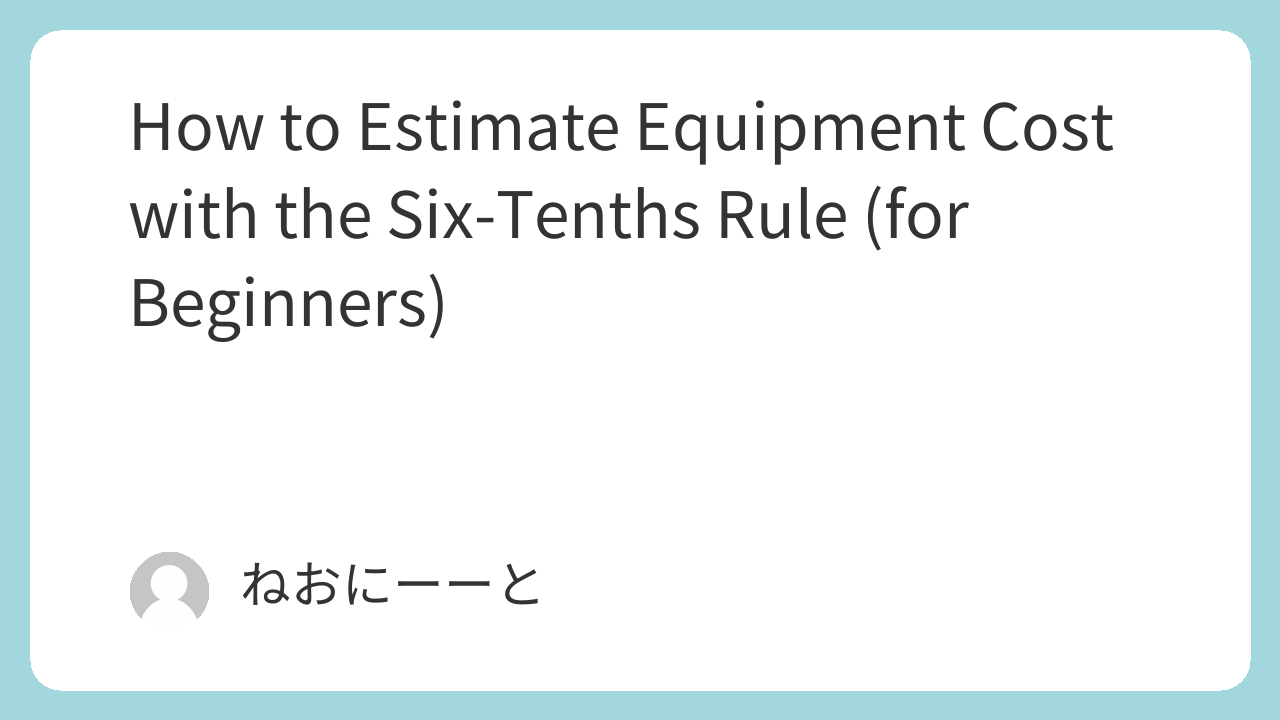In the early stages of a plant project, you often need to estimate equipment costs without detailed quotes. The Six-Tenths Rule is a simple and fast way to do this.
Even if you’re a beginner in engineering or project planning, you can use this rule to get a rough cost idea based on equipment size.
Understanding Cost Estimates in Plant Design: A Simple Example for Beginners
How to Quickly Estimate Pipe Lengths in Chemical Plants | Practical Tips for Engineers
From Estimates to Reality: Making Reliable Budgets for Plant Equipment Purchases
Practical Methods to Estimate Utility Usage in Chemical Plants Without Flow Meters
Lang Factor Explained: A Simple Way to Estimate Chemical Plant Costs
What Is the Six-Tenths Rule?
The Six-Tenths Rule (also written as the 0.6 exponent rule) says:
Cost₂ = Cost₁ × (Size₂ / Size₁)^0.6

This means that when the size of equipment increases, the cost increases—but not in a straight line.
Instead, costs grow more slowly than size, thanks to economies of scale.
When Is This Rule Useful?
This rule helps when you:
- Don’t have a supplier quote yet
- Need a quick estimate for budgeting
- Want to compare equipment sizes
Example:
If a 1,000 L reactor costs $100,000, a 2,000 L reactor would cost:100,000 × (2,000 / 1,000)^0.6 ≈ $151,000
1. Applying the Six-Tenths Rule in Batch Plant Construction
In batch plant projects, cost estimation often starts with the Lang factor — a multiplier that relates equipment cost to the total plant cost.
| Equipment | Lang Factor | Unit Cost (×10,000 JPY) | Quantity | Subtotal (×10,000 JPY) |
|---|---|---|---|---|
| Reactor A | 5 | 2,000 | 2 | 200,000 |
| Pump | 5 | 100 | 30 | 15,000 |
| Heat Exchanger | 5 | 500 | 4 | 100,000 |
| Others | 5 | 10,000 | 15 | 50,000 |
| Total | — | — | — | 365,000 + 5X |
When the main reactor’s cost is known — say 2,000 × 10,000 JPY for a 10 m³ vessel — multiplying by the Lang factor gives the estimated total plant cost:
2,000 × 5 = 10,000 × 10,000 JPY (≈ 1 billion JPY)
2. Estimating Unknown Equipment with the Six-Tenths Rule
If the cost of a larger reactor (e.g., 20 m³) is unknown, apply the six-tenths rule:
(20 / 10)^0.6 × 2,000 = 3,140 × 10,000 JPY
Then multiply by the Lang factor:
3,140 × 5 = 15,700 × 10,000 JPY
This approach helps fill data gaps without needing detailed vendor quotations.
3. Why It Doesn’t Scale Linearly
Applying the rule to an entire batch plant based on reactor count often leads to overestimation.
Unlike continuous plants, batch facilities lack enough comparable data to generalize cost ratios reliably.
Therefore, the Lang factor should be applied to each equipment item, not to the entire plant.
4. Equipment Replacement and the Rule’s Limitations
When upgrading a single reactor (e.g., replacing a 10 m³ vessel with a 20 m³ one), the six-tenths rule gives a quick estimate — but beware of accuracy issues.
Installation complexity, material price fluctuations, and additional work (like piping or electrical modifications) can cause large deviations.
Thus, the rule works best as a first approximation, not a final budget.
Notes for Batch Chemical Plants
In batch-type chemical plants, equipment sizes and usage vary more than in continuous plants.
So, the Six-Tenths Rule gives only a rough guide—final costs depend on materials, pressure ratings, and special functions.
Still, it’s a good first step when planning.
Conclusion
The Six-Tenths Rule is a helpful tool for early cost estimation.
It’s not exact, but it’s better than guessing. Engineers and planners can use this method to plan smarter and faster.
If you’re new to plant design or project work, keep this rule in your toolbox!

Comments